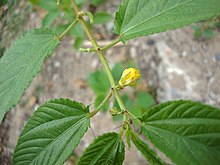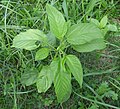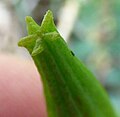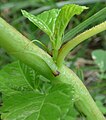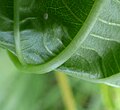
Jute is a long, rough, shiny bast fibre that can be spun into coarse, strong threads. It is produced from flowering plants in the genus Corchorus, of the mallow family Malvaceae. The primary source of the fiber is Corchorus olitorius, but such fiber is considered inferior to that derived from Corchorus capsularis.

Pseudopodospermum hispanicum, commonly known as black salsify or Spanish salsify, also known as black oyster plant, serpent root, viper's herb, viper's grass or simply scorzonera, is a perennial species of plant in the sunflower family (Asteraceae), cultivated as a root vegetable in the same way as purple salsify, also in the sunflower family. It is native to Southern Europe and cultivated as a crop in Southern and Central Europe. It grows on nutrient poor soils, dry pasture, rocky areas, in thickets and on limy or marly soils of temperate zones.

The mung bean, alternatively known as green gram, mungo bean or mongo bean, is a plant species in the legume family. The mung bean is mainly cultivated in East, Southeast and South Asia. It is used as an ingredient in both savoury and sweet dishes.

Tragopogon porrifolius is a plant cultivated for its ornamental flower and edible root. It also grows wild in many places and is one of the most widely known species of the salsify genus, Tragopogon. It is commonly known as purple or common salsify, oyster plant, vegetable oyster, Jerusalem star, Jack go to bed, or simply salsify.

The winged bean, also known as cigarillas, goa bean, four-angled bean, four-cornered bean, manila bean, princess bean, star bean, kamrangi bean, pea, dragon bean, is a tropical herbaceous legume plant.

Corchorus is a genus of about 40–100 species of flowering plants in the family Malvaceae, native to tropical and subtropical regions throughout the world.

Ziziphus mauritiana, also known as Indian jujube, Indian plum, Chinese date, Chinese apple, ber and dunks is a tropical fruit tree species belonging to the family Rhamnaceae. It is often confused with the closely related Chinese jujube, but whereas Z. jujuba prefers temperate climates, Z. mauritiana is tropical to subtropical.

Lupinus mutabilis is a species of lupin grown in the Andes, mainly for its edible bean. Vernacular names include tarwi, chocho, altramuz, Andean lupin, South American lupin, Peruvian field lupin, and pearl lupin. Its nutrient-rich seeds are high in protein, as well as a good source for cooking oil. However, their bitter taste has made L. mutabilis relatively unknown outside the Andes, though modern technology makes it easier to remove the bitter alkaloids. Like other species of lupin beans, it is expanding in use as a plant-based protein source.

Telfairia occidentalis is a tropical vine grown in West Africa as a leaf vegetable and for its edible seeds. Common names for the plant include fluted gourd, fluted pumpkin, ugu, okwukwo-wiri, and ikong-ubong, "Akwukwor ri". T. occidentalis is a member of the family Cucurbitaceae and is indigenous to southern Nigeria. The fluted gourd grows in many nations of West Africa, but is mainly cultivated in southeastern Nigeria and it is used primarily in soups and herbal medicines. Although the fruit is inedible, the seeds produced by the gourd are high in protein and fat, and can, therefore, contribute to a well-balanced diet. The plant is a drought-tolerant, dioecious perennial that is usually grown trellised.
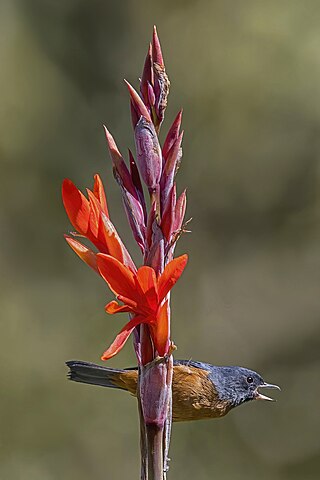
Canna indica, commonly known as Indian shot, African arrowroot, edible canna, purple arrowroot, Sierra Leone arrowroot, is a plant species in the family Cannaceae. It is native to much of South America, Central America, the West Indies, and Mexico. It is also naturalized in the southeastern United States, and much of Europe, sub-Saharan Africa, Southeast Asia, and Oceania.

Moringa oleifera is a fast-growing, drought-resistant tree of the family Moringaceae, native to the Indian subcontinent and used extensively in South and Southeast Asia. Common names include moringa, drumstick tree, horseradish tree, or malunggay.
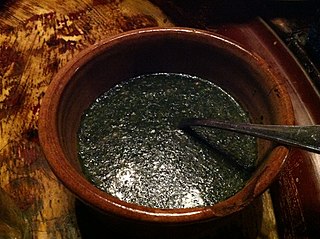
Mulukhiyah, also known as mulukhiyya, molokhiyya, melokhiyya, or ewedu, is a type of jute plant and a dish made from the leaves of Corchorus olitorius, commonly known in English as jute, jute leaves, jute mallow, nalta jute, or tossa jute. It is used as a vegetable and is mainly eaten in Egypt, the Levant, Sudan, Cyprus, Libya, Tunisia and Algeria. It is called saluyot in the Philippines. Mulukhiyah is rather bitter, and when boiled, the resulting liquid is a thick, highly mucilaginous broth; it is often described as "slimy", rather like cooked okra. Mulukhiyah is generally eaten cooked, not raw, and it is either eaten chopped and sautéed in oil, garlic and cilantro like in Syria or turned into a kind of soup or stew like in Egypt, typically bearing the same name as the vegetable in the local language. Traditionally mulukhiyah is cooked with chicken or at least chicken stock for flavor and is served with white rice, accompanied with lemon or lime.

Corchorus capsularis, commonly known as white jute, is a shrub species in the family Malvaceae. It is one of the sources of jute fibre, considered to be of finer quality than fibre from Corchorus olitorius, the main source of jute. The leaves are used as a foodstuff and the leaves, unripe fruit and the roots are used in traditional medicine.

Crotalaria juncea, known as brown hemp, Indian hemp, Madras hemp, or sunn hemp,धाकटी घागरी, is a tropical Asian plant of the legume family (Fabaceae). It is generally considered to have originated in India.

Napa cabbage is a type of Chinese cabbage originating near the Beijing region of China that is widely used in East Asian cuisine. Since the 20th century, it has also become a widespread crop in Europe, the Americas and Australia. In much of the world, it is referred to as "Chinese cabbage". In Australia it is sometimes referred to as "wombok".
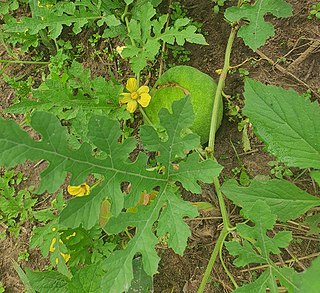
Melothria sphaerocarpa is a species of melon native from southern Mexico and the Dominican Republic through Central America to tropical South America. It has been introduced to western tropical Africa, where has been known under the synonym Cucumeropsis mannii, and is grown for food and as a source of oil, more often for the seed oil than for the fruit.
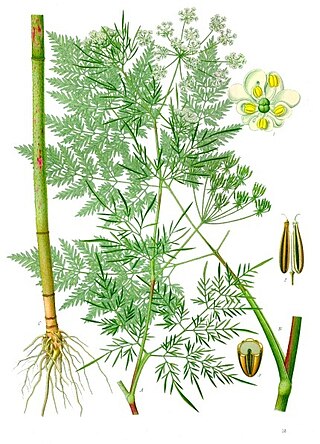
Chaerophyllum bulbosum is a species of flowering plant from the carrot family and known by several common names, including turnip-rooted chervil, tuberous-rooted chervil, bulbous chervil, and parsnip chervil. It is native to Europe and Western Asia. It was a popular vegetable in the 19th century.
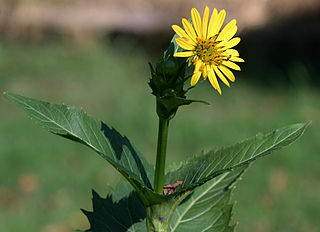
Silphium perfoliatum, the cup plant or cup-plant, is a species of flowering plant in the family Asteraceae, native to eastern and central North America. It is an erect herbaceous perennial with triangular toothed leaves, and daisy-like yellow composite flower heads in summer.

Neustanthus is a monotypic genus of flowering plants belonging to the pea family Fabaceae and its tribe Phaseoleae. The only species is Neustanthus phaseoloides, called tropical kudzu. This species is a forage crop and cover crop used in the tropics. It is known as puero in Australia and tropical kudzu in most tropical regions.

The production of fenugreek in India is marked by its dominant position in world production and export. Within India Rajasthan accounts for its largest cropped area and production. The fenugreek plant is an annual herbaceous forage legume with aroma, which is used for food in the form of its seeds as spices, and its leaves as a vegetable. It is also used as a medicinal herb in several Ayurvedic formulations for treatment of dry skin, boils, hair loss and so forth.
